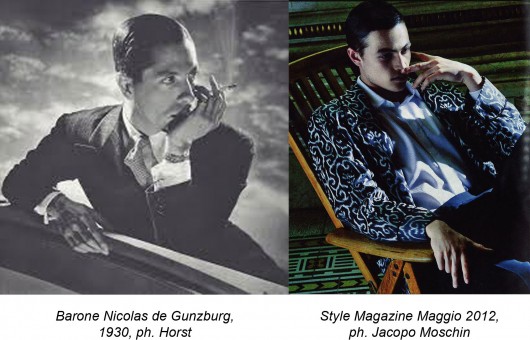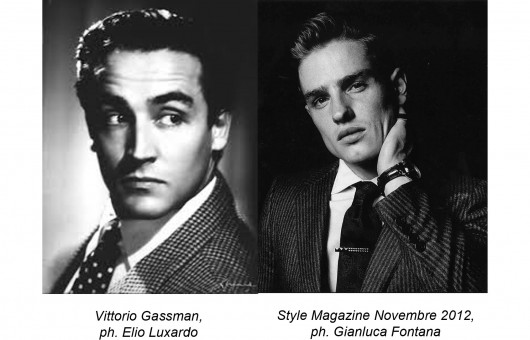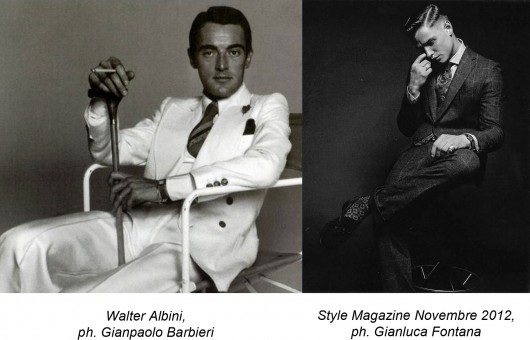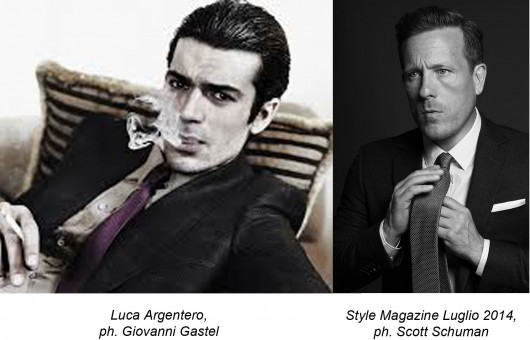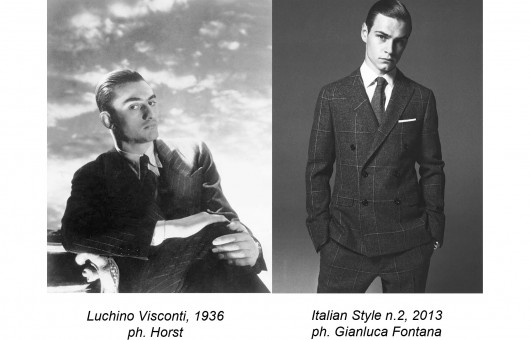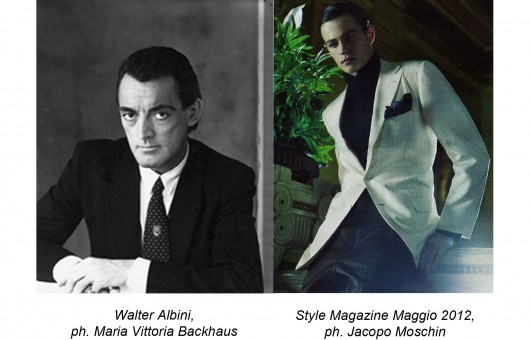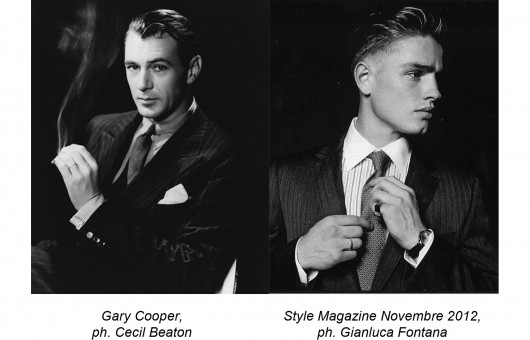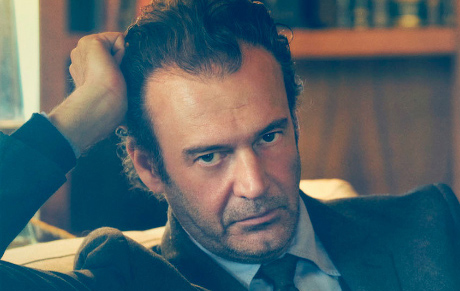GENTLEMAN’S PORTRAIT
Pur da inguaribile cinefilo, chi scrive riconosce alla macchina fotografica una capacità di sicuro più nobile e sofisticata di quelle che può sviluppare una cinepresa nel catturare la bellezza, l’eleganza, l’appeal di uomini e donne nel modo in cui essi si rappresentano attraverso il vestire. Una capacità che è stata e continua ad essere praticata anche quando è applicata alla moda maschile. Questa straordinaria potenzialità vale, in primo luogo, per la fotografia d’autore, quella dei grandi protagonisti di una pratica che ha tutte le carte in regola per essere definita arte, sommando in sé abilità tecnica ed estro, talento e slancio, obiettività e senso per la fascinazione, lettura oggettiva ed interpretazione.
E’ corretto affermare che i grandi fotografi di moda abbiano contribuito a costruire lo stile contemporaneo, assolvendo ad un compito che segue immediatamente quello del creatore per importanza e rilievo. La fotografia di moda è “l’occhio” della moda stessa. E’ la dimensione in cui l’eleganza giunge al pubblico, nelle immagini pubblicitarie come in quelle redazionali, ma anche in immagini che non sono strettamente “di moda” e che possono essere definite, in senso generale, ritratti, di personaggi noti ovvero di persone comuni, in cui comunque si focalizza l’identità – innanzitutto estetica, ma non solo – del soggetto prescelto. Senza contare che la moda, in estrema sintesi, è sostanza ed immagine insieme.
In altri termini: la moda vive nell’immagine e in essa trova, come si è detto sopra, il suo punto d’arrivo. L’idea di un abito nasce nella mente del creatore e compie un lungo percorso, che passa dal progetto fissato spesso in uno schizzo, dal prototipo, dal capo proposto prima in passerella e poi in vetrina, sino alla fotografia che è un po’ il punto di snodo e di raccordo insieme tra “tutto ciò che viene prima” ed il prodotto che giunge nella strada, viene indossato perché reso desiderabile proprio grazie allo scatto che lo rappresenta e sul quale tutti noi ci basiamo per orientare le nostre scelte.
Per quanto attento all’estetica un regista possa essere – un nome per tutti, Luchino Visconti -, il fotografo ha bisogno di maggiore impegno per cogliere l’essenza dell’eleganza. L’approccio ad essa è forzatamente diverso. Rispetto al primo, il secondo ha il vincolo della staticità. Il regista può raccontare, per esempio, la bellezza di una giacca mentre l’attore la indossa o la toglie, mentre balla, magari mentre abbraccia la partner per baciarla, valendosi anche del mutare delle luci e delle atmosfere. Il fotografo deve esprimere tutto ciò in uno scatto fisso, suggerendo il medesimo grado di appeal con mezzi differenti. E’ chiaro che contano anche in questo caso luci, pose ed ambientazioni.
Ma lo scatto fisso resta uno scatto fisso. Deve concentrare e condensare emozioni in un’unica immagine, in grado di far sognare tanto quanto una serie di fotogrammi di una pellicola. Tutto deve essere colto in un singolo attimo. Forse è una tesi azzardata, ma, considerato quanto esposto sin qui, può essere sensato affermare che nella fotografia, continuando a ragionare in parallelo con il cinema, è più intensa e più profonda l’interazione tra l’abito e chi lo indossa, in altre parole tra il “cosa” e il “chi”. Del resto l’eleganza non si esaurisce nell’esteriorità. Viene da dentro, dal fascino personale, dal carisma, dall’intelligenza dell’individuo.
Fatta salva la qualità del prodotto, sono queste le doti che portano l’individuo stesso a vivere il capo in una certa maniera, così da renderlo iconico, da creare uno stile, un modo di interpretare la moda che di volta in volta può essere severo o disinvolto, sobrio o eccentrico. Questo spiega perché non pochi modelli di riferimento per il fascino maschile non sono uomini necessariamente attraenti, né legati in esclusiva allo star system.
In questa logica, ha senso allargare un po’ la panoramica e considerare anche i “non addetti ai lavori”: i fotografi che non si occupano affatto di moda e che magari non hanno un nome né conosciuto né riconosciuto, ma che sono riusciti a fissare in uno scatto lo stile autentico, quello di uomini, di personaggi pubblici forse inconsapevolmente eleganti, anche nel senso più diretto del termine, ma soprattutto ricchi di qualità interiori. Al punto da lasciare un segno nella storia e da occupare un posto di rilievo nell’immaginario collettivo. Giorgio Re
Even if I’m a hopeless cinephile, I give credit to photography in catching beauty, elegance, appeal of men and women in a more refined way than the film camera. A skill used, now and in the past, also with men’s fashion. This extraordinary potentiality affects, fist of all, signature photos, which can be nearly defined art and consists of technical skill and inspiration, talent and passion, objectivity and fascination, analysis and interpretation. The great fashion photographers have contributed to build the contemporary style, with an assignment that follows immediately the designer’s one, in terms of importance and significance. Fashion photography is the “eye” of fashion itself. It’s the dimension through elegance comes to audience, in adv pictures as well as in editorials, but also in pictures not strictly “fashion” that can be defined portraits. Not to mention that fashion, in a nutshell, is substance and image together. In other terms: fashion lives through images and in them it finds its arrival point. The concept of a garment starts in designer’s mind and passes through a long path, from the draft, the prototype, the garment (displayed on the catwalk, then in the shops), to the photography, that is a kind of both a meeting and turning point between “everything that comes before” and the clothes worn on the street, worn just because the photo shots have made them attractive and have guided our choices. No matter how careful to details a filmmaker is – one for all, Luchino Visconti -, the photographer needs more application to catch elegance’s essence. The approach is necessarily different. The photographer has the restriction of static nature. The filmmaker can show, for example, the beauty of a jacket while the actor wears it or takes it off, dances, maybe hugs his partner to kiss her, using also different lights and ambiances. The photographer has to express all that in a fixed shot, evoking the same amount of appeal with different means. Lights, poses and locations are clearly important in this case too. But a fixed shot remains a fixed shot. It must focus and condense emotions in a single image, able to make us dream just like a sequence of frames of a film. Everything must be caught in a single moment. Maybe this is a risky theory, but, considering what has been said till now, we can say that in photography the interaction between the clothes and who wears them, so between the “what” and the “who”, is stronger than in movies. Infact elegance doesn’t express itself only in the outward appearance. It comes from the inside, from charm, personality, intelligence. These are the features that lead a person to live the garment in a certain way, that makes it iconic, that creates a style, a way of playing with fashion that time after time can be severe or relaxed, sober or eccentric. This explains why a lot of charming icons aren’t necessarily handsome men, nor tied exclusively to star system. In this context, it makes sense to enlarge the overview and talking about the photographers, maybe not popular and acknowledge, that don’t work with fashion but have been able to catch in a shot the authentic style of men, of, maybe unconsciously, elegant personalities. Which means also rich of inner qualities. So much that they left a sign in history and have an important place in collective imagination. Giorgio Re





